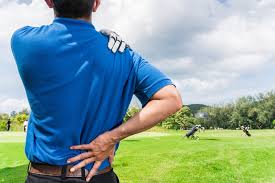
Getting Into The Swing Of Things
written by Matt Onderdonk, PT, DPT, OCS
The days are getting longer, the frost delays are getting shorter, and we’ve just wrapped up the first major of the year. If you found yourself in the backyard swinging the club for the first time in months, you’re not alone.
The pros make the game look so simple on TV, but we often overlook how much time they take to prepare their bodies and swings. The high speed and rotational loading in the golf swing can take their toll with the three most common pain sites in the low back, shoulders and knees.

If your prep for the round involves a few ibuprofen, a small bucket of balls, and a quick stretch of the hamstrings, you’re probably setting yourself up for some pain and soreness. Did you know that professional golfers spend more time working on stabilizing rotation rather than flexibility in their warm-up? The correct posture and controlled range of motion through your trunk, especially the thoracic spine, are key to preventing some of the more common golf injuries..

As a physical therapist, my approach to golf prep and injury prevention starts with understanding your body and how it can impact your swing. With a detailed biomechanics assessment and swing screen we can help identify swing characteristics that not only contribute to injury, but also affect your performance.
A simple, structured approach to training your body can help you optimize your movement patterns and create a smooth, pain free swing. Increased distance is often a happy side effect, but this can be enhanced with strength and speed training.
It’s important to note that I won’t be able to replace your swing coach, golf pro, or hours at the driving range. The goal of any PT golf training program is to help our golfers minimize injury risk, improve club head speed, and keep you on the course until you’re old and gray.
